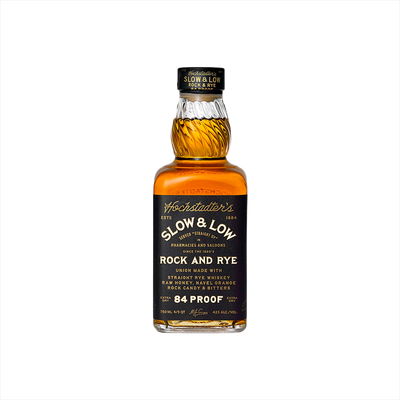Rock and Rye
What is Rock and Rye?
Rock and Rye is a traditional American medicinal cocktail that belongs to the category of Other Cocktails, originally created as a folk remedy for colds and coughs during the late 1800s. This warming drink combines rye whiskey with rock candy (crystallized sugar), citrus fruits like lemon or orange, and various spices such as cinnamon, cloves, or horehound. What defines Rock and Rye is its dual nature as both a soothing medicinal tonic and an enjoyable cocktail, with the rock candy slowly dissolving to create a sweet, spiced whiskey infusion that was believed to cure winter ailments.
Learn More About Rock and Rye
What makes Rock and Rye unique?
Rock and Rye stands apart as one of America's oldest medicinal cocktails, originally created as a folk remedy that combined rye whiskey with rock candy and various fruits like oranges or cherries. Unlike modern cocktails that are mixed fresh each time, Rock and Rye was traditionally bottled and aged, allowing the ingredients to meld together over weeks or months into a sweet, spiced elixir. This pre-bottled nature made it both a convenient cure-all during the 19th century and a sophisticated sipper that bridges the gap between straight spirits and flavored liqueurs.
How is Rock and Rye made?
Rock and Rye starts with straight rye whiskey that gets infused with rock candy (crystallized sugar) and a blend of citrus fruits, typically orange peel and lemon. The mixture steeps for weeks or months, allowing the sugar to dissolve slowly while the citrus oils extract into the whiskey, creating a sweet and slightly spiced liqueur. Some producers add warming spices like cinnamon, cloves, or horehound during the infusion process to give their version additional complexity and medicinal character.
How do you drink Rock and Rye?
Rock and Rye shines best when sipped neat or on the rocks, letting you appreciate its warming spice blend and fruit flavors without dilution. Many folks enjoy it as a cold-weather sipper or use it in whiskey-forward cocktails like Old Fashioneds and Manhattans, where it adds sweetness and complexity without needing additional simple syrup. The liqueur's medicinal heritage makes it a natural choice for fall and winter evenings, especially when you're feeling under the weather or want something comforting after a long day outdoors.
How do I choose good Rock and Rye?
When selecting a Rock and Rye, look for bottles that list real ingredients like actual rye whiskey, rock candy or cane sugar, and citrus peels rather than artificial flavors and high fructose corn syrup. For sipping neat or on the rocks, go with premium versions from craft distilleries that use aged rye whiskey as their base, while more affordable commercial brands work perfectly fine in mixed drinks where other ingredients will complement the sweetness. Consider how you plan to serve it—if you're making hot toddies or punches, a spicier, less sweet Rock and Rye will balance better with warm spices and citrus.
Nutritional Information
Typical Calorie Range per Ounce: 80-120 calories
Typical Carbohydrate Range per Ounce: 8-15 grams
Typical Sugar Range per Ounce: 6-12 grams
Typically Gluten Free: No
Rock and rye gets its sweetness from added sugar, rock candy, and sometimes honey, which accounts for the higher carbohydrate and sugar content compared to straight rye whiskey. The calorie count reflects both the alcohol content and these added sweeteners. Most traditional rock and rye products contain rye whiskey as their base, making them unsuitable for those avoiding gluten. Some craft distillers now produce gluten-free versions using alternative grains, but these remain the exception rather than the rule. Always check the specific product label and contact the manufacturer directly to confirm gluten-free status, especially if you have celiac disease or severe gluten sensitivity.
Scrolled this far? Your reward? Rock and Rye Trivia!
- Rock and Rye was originally sold as medicine in American pharmacies during the 1800s, marketed as a cure for everything from coughs to consumption. Bartenders would literally prescribe it to customers, complete with dosage instructions written on small paper slips tucked behind the bar.
- The "rock" in Rock and Rye refers to rock candy sugar, but many bottles also contained actual rocks - specifically horehound rock candy that was believed to have medicinal properties. Some distilleries would age their whiskey with chunks of this candy still floating in the barrel, creating a naturally sweet infusion.
- During Prohibition, Rock and Rye became one of the most bootlegged spirits in America because its medicinal reputation made it easier to smuggle and sell. Speakeasy owners would often add their own secret ingredients like dried fruits, herbs, and spices, leading to hundreds of regional variations that have never been documented.
- The Pennsylvania Dutch communities developed their own version called "Schnaps and Stone" that included wintergreen oil and birch bark extract. This regional variant was so potent that it was traditionally served in thimble-sized portions and used as both a digestif and a topical pain reliever.
- Modern craft distilleries have discovered that the original Rock and Rye recipes often included ingredients that are now illegal or restricted, such as coca leaves and laudanum. Some contemporary versions attempt to recreate these effects using legal botanicals like kola nut and valerian root, though the results taste nothing like their historical counterparts.
Higher-proof spirits can be intense. Mix carefully, taste thoughtfully, and enjoy responsibly.
Gift message (optional)

